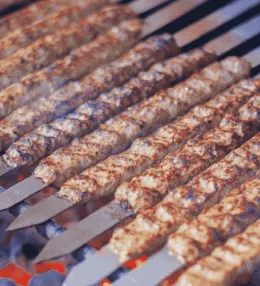
- View
Table of Contents
ToggleLemang is one of those traditional Malaysian foods that tells a story before you even take a bite. You see it lined up along roadside stalls during festive seasons, especially around Hari Raya, its bamboo casing charred and fragrant, hinting at the smoky rice within.
At first glance, it might seem like a simple snack, but lemang is deeply tied to the rhythm of rural life, celebration, and a sense of communal cooking that’s increasingly rare. This glutinous rice delicacy, slow cooked in bamboo over open flame, captures the essence of patience and heritage in every slice.
Want to dive deeper into Malaysian Cuisine? Don’t miss our post on 27 Traditional Malaysian Foods to Try
What Is Lemang?
Lemang is glutinous rice cooked with coconut milk inside a hollowed bamboo stalk that has been lined with banana leaves. The preparation might sound straightforward, but it requires time, skill, and close attention to get right.
As the bamboo rotates over a fire, the heat slowly cooks the rice, infusing it with the smoky aroma of the firewood and the subtle fragrance of the banana leaf. Once cooked, the bamboo is split open to reveal a cylindrical log of tender, creamy rice with a slightly toasted outer layer.
Lemang is typically served in slices and often paired with rich meats like beef rendang or spicy sambal for contrast, though it’s just as enjoyable on its own.
Ingredients and Taste
At the heart of lemang are three key elements: glutinous rice, coconut milk, and salt. The rice is soaked and then mixed with lightly salted coconut milk, absorbing the creamy richness before being packed into the bamboo tubes.
Banana leaves are wrapped inside the bamboo, acting as a natural lining that not only prevents sticking but also adds a subtle herbal note as the rice cooks.
The result is comforting and moreish. The texture is firm yet sticky, holding its shape when sliced, with a golden crust where the rice has caramelised against the banana leaf. The taste is rich, slightly salty, and creamy with a gentle smokiness that lingers.
While simple in components, lemang’s flavour relies entirely on the quality of ingredients and the care taken during its long cooking process. It’s one of those dishes where the method shapes the outcome just as much as the ingredients do.
A Taste of History
Lemang‘s origins are closely tied to the indigenous communities of Malaysia and Indonesia, particularly among the Minangkabau people. Traditionally cooked during major festivals and harvest celebrations, lemang was not just food but a communal ritual.
The process of preparing it over a wood fire brought families and neighbours together, often in the lead up to important events like Hari Raya Aidilfitri or weddings.
Over time, lemang became a familiar sight throughout Malaysia, its presence marking moments of togetherness and festivity. Though modern stoves and rice cookers have taken over many kitchens, lemang remains a symbol of cultural pride.
It continues to hold its ground as a time honoured favourite, its preparation a reminder of a slower, more deliberate way of life. Whether bought from a roadside vendor or made from scratch with family, lemang brings more than just flavour to the table, it brings heritage, warmth, and a connection to the past that still resonates today.
How To Make Lemang
Ingredients:
- 500g glutinous rice (sticky rice), rinsed and soaked for 6 hours
- 400ml thick coconut milk
- 1¼ tsp salt
- 2 pandan leaves, tied into a knot (optional but recommended)
- Banana leaves (for lining, fresh or thawed if frozen)
- Aluminium foil (if not using bamboo)
- Optional: bamboo tubes (traditionally used)
Instructions
Step 1/9
To begin, rinse the soaked glutinous rice thoroughly until the water runs mostly clear. This removes excess starch and ensures the rice grains don’t become overly gummy. Drain the rice well using a fine mesh strainer, letting it sit for 10–15 minutes to eliminate residual water.
Step 2/9
In a large mixing bowl, combine the drained glutinous rice with coconut milk and salt. Mix thoroughly with your hands or a spoon, making sure each grain is coated evenly. If using pandan leaves, place them in the bowl and stir gently to infuse a subtle fragrance.
Step 3/9
Prepare your banana leaves by cutting them into rectangles approximately 25 x 20 cm. Briefly steam or pass them over an open flame to soften, making them pliable for rolling without tearing.
Step 4/9
Lay one banana leaf flat, then spoon about 3–4 tablespoons of the coconut rice mixture onto it. Shape it into a short log, then roll the leaf snugly around the rice, tucking in the sides. Wrap the parcel securely in aluminium foil to lock in moisture and prevent leaking during cooking.
Step 5/9
If using bamboo tubes (ideal for smoky flavour), line the inside of each tube with banana leaves, then gently pack in the rice mixture, pressing down lightly. Leave about 3–4 cm of space at the top to allow the rice to expand.
Step 6/9
Preheat your oven to 180°C (fan) or 200°C (conventional). Arrange the wrapped lemang parcels upright or on their sides in a baking tray lined with foil. If using bamboo tubes, stand them vertically in a deep tray to prevent rolling.
Step 7/9
Bake for approximately 2–2½ hours. Rotate the parcels every 30 minutes to ensure even cooking. If you’re using bamboo, rotate the tubes gently for even heat distribution. The rice is ready when it’s fully cooked, sticky yet separate, and emits a lightly toasted coconut aroma.
Step 8/9
Allow the lemang to rest for at least 15 minutes before unwrapping. This settling time firms up the rice and makes slicing easier. Use a sharp, lightly oiled knife to slice the lemang into thick rounds.
Final Step/9
Serve the lemang warm or at room temperature. Traditionally, it’s paired with spicy rendang, serunding (spiced coconut floss), or sambal. For presentation, place the slices on a banana leaf lined platter and accompany with dipping condiments like sambal belacan or acar.

Malaysian Lemang (Glutinous Rice in Bamboo)
Equipment
- Large mixing bowl
- Fine mesh strainer
- Knife and cutting board
- Scissors (for cutting banana leaves)
- Spoon or spatula
- Aluminium foil
- Oven or charcoal grill
- Baking tray (lined with foil)
- Steamer or open flame (for softening banana leaves)
- Bamboo tubes (optional, for traditional preparation)
- Tongs or oven gloves (for safe handling during rotation)
Ingredients
- 500 g glutinous rice sticky rice, rinsed and soaked for 6 hours
- 400 ml thick coconut milk
- 1¼ tsp salt
- 2 pandan leaves tied into a knot (optional but recommended)
- Banana leaves for lining – fresh or thawed if frozen
Instructions
- To begin, rinse the soaked glutinous rice thoroughly until the water runs mostly clear. This removes excess starch and ensures the rice grains don’t become overly gummy. Drain the rice well using a fine mesh strainer, letting it sit for 10–15 minutes to eliminate residual water.
- In a large mixing bowl, combine the drained glutinous rice with coconut milk and salt. Mix thoroughly with your hands or a spoon, making sure each grain is coated evenly. If using pandan leaves, place them in the bowl and stir gently to infuse a subtle fragrance.
- Prepare your banana leaves by cutting them into rectangles approximately 25 x 20 cm. Briefly steam or pass them over an open flame to soften, making them pliable for rolling without tearing.
- Lay one banana leaf flat, then spoon about 3–4 tablespoons of the coconut rice mixture onto it. Shape it into a short log, then roll the leaf snugly around the rice, tucking in the sides. Wrap the parcel securely in aluminium foil to lock in moisture and prevent leaking during cooking.
- If using bamboo tubes (ideal for smoky flavour), line the inside of each tube with banana leaves, then gently pack in the rice mixture, pressing down lightly. Leave about 3–4 cm of space at the top to allow the rice to expand.
- Preheat your oven to 180°C (fan) or 200°C (conventional). Arrange the wrapped lemang parcels upright or on their sides in a baking tray lined with foil. If using bamboo tubes, stand them vertically in a deep tray to prevent rolling.
- Bake for approximately 2–2½ hours. Rotate the parcels every 30 minutes to ensure even cooking. If you’re using bamboo, rotate the tubes gently for even heat distribution. The rice is ready when it’s fully cooked, sticky yet separate, and emits a lightly toasted coconut aroma.
- Allow the lemang to rest for at least 15 minutes before unwrapping. This settling time firms up the rice and makes slicing easier. Use a sharp, lightly oiled knife to slice the lemang into thick rounds.
- Serve the lemang warm or at room temperature. Traditionally, it's paired with spicy rendang, serunding (spiced coconut floss), or sambal. For presentation, place the slices on a banana leaf lined platter and accompany with dipping condiments like sambal belacan or acar.
Nutrition
You May Also Like






